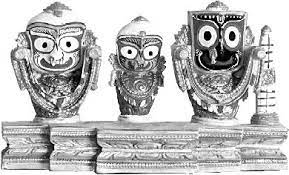Jagannath, the deity of the famous Jagannath Temple in Puri, Odisha, Jagannath in Literature holds a significant place in the cultural fabric of India. For centuries, this divine figure has captivated the imagination of poets, writers, and artists, resulting in numerous literary works dedicated to his glory. One such notable contribution to this enchanting saga is “Sri Purushottam Chandrika,” a literary masterpiece that revisits the timeless devotion to Jagannath.
“Sri Purushottam Chandrika” is an epic poem written by Vidyapati, a 14th-century poet, musician, and scholar hailing from Mithila, the present-day Bihar in India. In this magnum opus, Vidyapati skillfully weaves together various folk tales, legends, and religious beliefs associated with Jagannath, crafting a compelling narrative that explores the multifaceted facets of devotion.

You can read our another post on Twin Temple of Gandharadi: A Marvel of Ancient Architecture
The poem begins with an invocation to the Supreme Lord Jagannath, describing his divine attributes and the indescribable beauty that enthralls both mortals and celestials alike. Vidyapati portrays Jagannath as the quintessential embodiment of love and compassion, a divine force capable of transforming even the most hardened hearts.
The central theme of “Sri Purushottam Chandrika” revolves around Radha, the beloved of Lord Krishna, and her yearning to merge with Jagannath. Vidyapati explores the complexities of Radha’s emotions and the intense longing that drives her to seek divine union. Through his lyrical verses, he delves into the mystical realm of love and spirituality, putting forth profound philosophical questions about the nature of existence.
Vidyapati’s exquisite imagery and rich symbolism vividly bring to life the grandeur of the Jagannath Temple and its divine rituals. The poem beautifully captures the fervent devotion of the pilgrims who flock to Puri, their souls aflame with spiritual fervor. The sights, sounds, and smells of this ancient pilgrimage site are masterfully described, immersing the reader in the ethereal ambience of divinity.
In addition to celebrating Jagannath’s glory, Vidyapati’s “Sri Purushottam Chandrika” also tackles pertinent social issues of the time. The poem critiques the rigid caste system prevalent in medieval India, highlighting the power of devotion in transcending societal hierarchies. Vidyapati emphasizes that faith knows no boundaries and that the love for God unites people from all walks of life.
To this day, “Sri Purushottam Chandrika” continues to inspire scholars, researchers, and artists with its profound spiritual insights and literary craftsmanship. It stands as a testament to the enduring power of faith and the transformative effect of divine love. The poem not only offers a glimpse into the rich cultural heritage of Odisha but also serves as a source of contemplation and spiritual reflection for readers across generations.
Jagannath’s presence in literature is not limited to Vidyapati’s masterpiece alone. Over the centuries, poets and writers from various linguistic traditions have penned verses and stories honoring Jagannath, each contributing their unique perspectives and interpretations. Collectively, these literary works provide a tapestry of experiences and emotions, showcasing the timeless allure of Jagannath and his divine abode, Puri.
More: Wanted to download Odishashop.com visit here
Write A FAQ For Jagannath in Literature
1. What is “Jagannath in Literature: Sri Purushottam Chandrika Revisited”?
“Jagannath in Literature: Sri Purushottam Chandrika Revisited” is a book that explores the depiction and significance of Lord Jagannath, a Hindu deity, in the literary text called “Sri Purushottam Chandrika.” The book analyzes various aspects of this text and provides a fresh perspective on the representation of Jagannath in literature.
2. Who is the author of “Jagannath in Literature: Sri Purushottam Chandrika Revisited”?
The author of “Jagannath in Literature: Sri Purushottam Chandrika Revisited” is not mentioned in the question. If you could provide the author’s name, I could provide more information.
3. What are the main themes discussed in the book?
The book covers a range of themes related to the representation of Jagannath in literature. It explores the cultural and religious significance of Jagannath, the historical and mythological background surrounding the deity, the symbolism associated with him, and the impact of the deity’s portrayal on the readers.
4. Does the book provide any new insights or interpretations?
Yes, “Jagannath in Literature: Sri Purushottam Chandrika Revisited” offers new insights and interpretations regarding the depiction of Jagannath in “Sri Purushottam Chandrika.” The author provides a fresh perspective on the symbolism and meaning behind the various references to Jagannath in the text and engages in a critical analysis of its literary merit.
5. Who would benefit from reading this book?
This book would be of interest to scholars, researchers, and enthusiasts of Indian literature, Hindu mythology, and religious studies. It provides an in-depth examination of the representation of Jagannath in literature, making it a valuable resource for those interested in understanding the cultural and literary aspects of this deity.
Conclusion
In conclusion, “Sri Purushottam Chandrika” remains a significant milestone in the rich tapestry of Jagannath’s influence on literature. Vidyapati’s profound exploration of love, devotion, and the quest for spiritual union continues to resonate with readers. As we revisit this cherished literary gem, we are reminded of the eternal bond between art and divinity, and the enduring appeal of Jagannath, who continues to reign supreme in the hearts and minds of devotees and literary enthusiasts alike.
